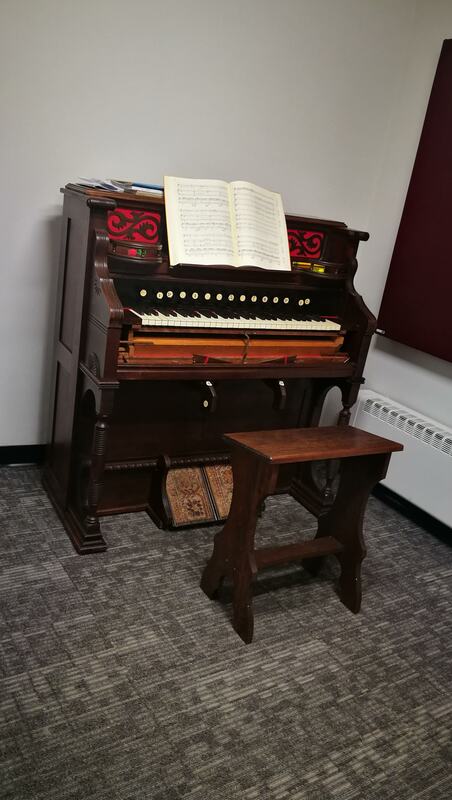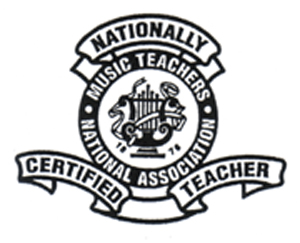|
[Special thanks to Ned Phoenix for his assistance with this blog entry!] My grandmother used to tell me: "You can be as old as a house... just don't ever stop learning!" In school, in life, and in music, I've found that to be solid advice. Sometimes the process is easy and fun, and other times it takes considerable effort. But it's never a waste of time. This past week I learned how to play a new instrument. I had been invited to play the harmonium part for the Dartmouth Glee Club's performance of the Petite Messe Solennelle by Gioachino Rossini. Until Tuesday, I had been serving as pianist for weekly rehearsals. On Tuesday, April 30, the instrument (an Estey reed organ - in the Style E parlor organ case - made in Brattleboro, Vermont in 1891) was delivered to Dartmouth, and I changed course: new instrument, new music. Four days to make it happen. Ned Phoenix (https://www.namm.org/library/oral-history/ned-phoenix) of Phoenix Reed Organ Resurrection in Townshend, Vermont owns this beautiful instrument, among many others of all sizes in his collection. He gave me a two hour lesson on how to play a reed organ. When he demonstrated the sound I immediately was amazed: the keys seemed to sing! Reed organs have wonderful expressive possibilities. So, what is a harmonium? Ned explained, "A reed organ is a glorified harmonica. Both have free reeds made of brass. Free reed instruments were invented in Europe during the 1820s, so they are relatively new instruments. The Harmonium is a standardized pressure-wind instrument patented by Debain in Paris in 1840, which is why the stop designations are in French. Its name and standard construction came into general use, and now "harmonium" is not usually capitalized. In the USA and Canada suction-wind "American organs" or "reed organs" were made without standardization of stops, which is why not much "serious" music was written for these instruments. "Pump organ" is a vernacular term for an American organ." 1. HEAD: I quickly discovered that playing this instrument would require quite a bit of physical coordination that I am not used to as a pianist. Forcing my brain to absorb new material, and my body to take on a new set of motions was a challenge. To be honest, for the first two days I truly wasn't sure if it would work out: I practiced in the mornings and late into the evenings. Only the evening before the crucial dress rehearsal (the only rehearsal with all the musicians together) did it finally click. 2a. FINGERS (Technique). Organ technique is really quite different from piano. Because an organist cannot create dynamic differences through articulation (the keys simply drop to the felt), when playing a reed organ the feet and right knee create the expression. The keys start the sound when you play them, but immediately cease to sound when you let go, thus, holding notes for their full durations and releasing exactly on the rests is essential technique. Playing organs requires continuous finger substitutions (playing a note with one finger, then changing the finger while holding the note to ensure that a finger is available for the next note), and trying to create legato chords and octaves requires "walking the thumb" (using the tip and knuckle as if they were two fingers!). Ned recommends placing your fingers on the tops of the keys and simply rocking your body on your sit bones: forward (to play), then almost sitting straight up (to release) all fingers simultaneously: "One thing is simpler and more accurate to move than ten things." 2b. FINGERS (Sounds Effects). Ned says, "Organs are the original synthesizers." There are multiple "stops" above the keyboard - pulling them allows different individual timbres of sound to be heard. The organist can also put together combinations of sounds (synthesis). Some stops operate special mechanical effects (the Coupler automatically adds an octave above each note that you play). Ned had gone through the score to determine what stops would be used for particular passages in the work. Now it was my job to push/pull the stops at the appropriate times - often while playing (thus, playing some right hand notes with the left hand so that the right hand could pull out or push in a stop knob). 2c. FINGERS (Accuracy). Based on the instant activation of any key that is pressed I would argue that playing a reed organ requires extreme accuracy - mistakes are much more audible than on a piano. A unified approach is necessary to make sure that all the notes in large chords sound at the same time (and, in my case, exactly at the time that the conductor requests it). 3. HEART (expression). Harmoniums were called "L'Orgue Expressif": the expressive organ. However, the organist cannot create dynamic differences through articulation - so there is no use in pressing the keys any harder than you have to. Expression is achieved by more or less pumping with the feet, and more or less opening of the swell with the right knee. The faster or more intensively the feet pump, the louder and/or more intense the sound; for diminuendo or to relax the sound, move the feet slower. Thus, reed organs provide an opportunity to create expressive dynamics, as well as to max out the volume for dramatic passages. 4. KNEES. The biggest surprise for me was the two levers operated by the player's knees; one for the left (Grand Orgue - full organ - activates all the stops at once, creating a very grand sound) and other for my right (Ouvert - open - allows incremental opening and closing of the swell shades (like a hand moving over a singer's mouth), allowing for dynamic subtleties). Thus, while eyes are reading the score and following the conductor, ears are listening to myself and other musicians, fingers are playing the keys and pulling stops, and feet are constantly changing speed... the knees would open and close the knee levers (and, not in synchrony). What a dance! 5. TOES. The air that is used to activate the reeds must be created by the player's feet which operate the bellows. Like a harmonica, without air pressure on the reeds the organ will not make any sound. Ned instructed me, "Two quick simultaneous pumps to get it started, and then alternate your feet." This instrument stretched my brain and my fingers (and my feet) and it felt great! The music was glorious and the reed organ added a beautiful dimension to the soundscape of the work. I had a wonderful experience working with talented musicians and people, and hope to have the opportunity to further develop these new skills in the future. ADDITIONAL RESOURCES:
Wikipedia article on Pump Organs: https://en.wikipedia.org/wiki/Pump_organ Nota Bene (per Ned Phoenix): Throughout the history of American reed organs, the names used denote both a case style and what one could expect for musical capabilities from each case style: lap organ, melodeon, parlor organ, chapel organ, two-manual with pedal. The Wiki article is misleading: Harmonium, melodeon, and parlor organ are all free reed instruments, but are not equivalent; each is constructed differently and has different musical capabilities. YouTube video “Ned Phoenix demonstrates the Estey JJ,” an interview done by the Brattleboro Historical Society https://www.youtube.com/watch?v=mFnSN8ea0zM The A435 Levi Fuller Extravaganza video in HD on Vimeo. 2012 event at Estey Organ Museum. http://vimeo.com/35763724
36 Comments
9/16/2019 11:37:37 pm
I am thankful to you for sharing this plethora of useful information. I found this resource utmost beneficial for me. Thanks a lot for hard work. Great job for publishing such a nice article. Your article isn’t only useful but it is additionally really informative. Thank you because you have been willing to share information with us.
Reply
12/8/2023 07:48:29 am
I appreciate, cause I found exactly what I was looking for. You’ve ended my four day long hunt! God Bless you man. Have a great day.
Reply
1/8/2021 09:51:07 am
Texto muito esclarecedor em relação, não só ao harmônio (instrumento), em si, mas no modo em que deve ser utilizado. A Música é muito mais que, apenas utilizar os recursos do harmônio.
Reply
2/9/2023 04:24:25 pm
Your articles are inventive. I am looking forward to reading the plethora of articles that you have linked here. Thumbs up!
Reply
3/24/2023 10:54:35 am
Stones and Cabinets City delights our customers and makes them proud of their houses by making the complex simple. Our expert designers are dedicated to producing layouts that ensure your design is distinctive to our clients’ liking as well as functional.
Reply
3/24/2023 10:57:28 am
We value the quintessential need for heating and cooling systems to keep your home or office climate moderate throughout efficiently. When they start to show signs of falling apart, don't wait for the problem to worsen.
Reply
3/24/2023 11:00:12 am
I-Cell Station identify your cell phone issues for free so that we can offer you the best possible solutions. We have expert-level solutions for all damaged cell phone devices, from screen replacements to charging ports and batteries, cameras speakers, back glass to motherboard level repairs.
Reply
3/24/2023 11:02:42 am
A blog is a discussion or informational website published on the World Wide Web consisting of discrete, often informal diary-style text entries. Posts are typically displayed in reverse chronological order so that the most recent post appears first, at the top of the web page
Reply
3/24/2023 11:07:39 am
Constructing a house in DHA (Defence Housing Authority) Karachi is a popular dream for many residents, as this well-planned area offers numerous facilities and modern amenities.
Reply
5/4/2023 10:05:15 am
The merit of a genuine leather jacket is that it never goes out of style, and the longer you wear it, the more comfortable it becomes. There's simply something about leather that any other...
Reply
7/29/2023 09:30:15 am
Please visit. I hope you like
Reply
7/29/2023 09:31:13 am
Please visit. I hope you like
Reply
12/14/2023 04:01:42 am
Thanks for a great blog. I was able to get the information that I had been looking for. Thanks once again!
Reply
2/8/2024 01:34:40 pm
Your writing is always thought-provoking. You challenge my assumptions and make me think about things in new ways. And if you're looking for Shoes that's both stylish and eco-friendly, Classic Mini Ugg Boots available at Tops and Bottoms USA is the best option. They are made from sustainable materials and are sure to make a positive impact.
Reply
2/16/2024 05:18:21 pm
An ESG advisory firm, or Environmental, Social, and Governance advisory firm, specializes in providing guidance and expertise to businesses seeking to integrate sustainable and socially responsible practices into their operations.
Reply
2/16/2024 05:21:21 pm
Car detailing is a meticulous automotive service that involves cleaning, restoration, and protection of a vehicle's exterior and interior to enhance its appearance and preserve its value. This process includes thorough cleaning, waxing, polishing, and often involves deep cleaning and rejuvenating the interior, leaving your car looking as good as new.
Reply
2/16/2024 05:22:49 pm
Zabihah Halal Chicken refers to chicken meat that has been prepared and processed in accordance with Islamic dietary laws. This involves following specific guidelines for slaughter and ensuring that the chicken is deemed permissible (halal) for consumption by adhering to Islamic principles. Zabihah Halal Chicken is an essential choice for individuals who observe halal dietary requirements and seek meat that complies with their religious beliefs.
Reply
2/16/2024 05:24:15 pm
Wellness Acupuncture Center is a dedicated healthcare facility that specializes in the ancient practice of acupuncture. With a focus on promoting holistic well-being, this center offers expert acupuncture services, which involve the precise insertion of fine needles into specific points on the body to enhance overall health and relieve various ailments. Whether you seek relief from pain, stress reduction, or improved energy flow, the Wellness Acupuncture Center is your destination for natural, alternative healing methods.
Reply
2/16/2024 05:25:47 pm
Boiler Repair Middlesex County offers comprehensive solutions for all your boiler maintenance and repair needs in Middlesex County. Our team of experienced technicians is dedicated to providing prompt and efficient service to ensure your boiler operates safely and effectively.
Reply
2/16/2024 05:27:23 pm
Heating and Cooling Services provides expert solutions for your indoor comfort needs. Our team specializes in installing, repairing, and maintaining heating, ventilation, and air conditioning systems to ensure optimal performance year-round.
Reply
2/16/2024 05:28:54 pm
Junk removal companies offer convenient solutions for individuals or businesses looking to declutter their spaces, renovate properties, or dispose of items that are no longer needed.
Reply
2/16/2024 05:30:27 pm
Baithakh, a culinary haven that tantalizes the taste buds with an exquisite array of flavors, presents menus that are a symphony of culinary craftsmanship. Each menu is carefully curated to deliver a delightful journey through a fusion of traditional and contemporary dishes, offering a gastronomic experience like no other.
Reply
2/16/2024 05:31:52 pm
Kraken Law Group stands as a beacon of excellence in the legal sphere, renowned for its unwavering commitment to client success and its unparalleled expertise in navigating complex legal landscapes.
Reply
Leave a Reply. |
AboutElizabeth Borowsky is a pianist, teacher, and composer. She is a Nationally Certified Teacher of Music in Piano (Music Teachers National Association). SubscribeCategories
All
Archives
May 2023
|
Location |
|









 RSS Feed
RSS Feed